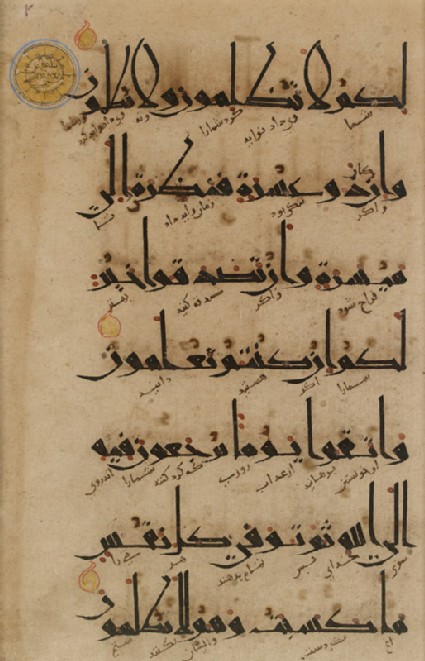Browse: 321 objects
- Reference URL
Actions
Part of a set with...
Page from a Qur’an in eastern kufic script and with Persian translation in naskhi script
-
Description
This folio originates from a rare manuscript of the Qur’an which combines Arabic verses with a Persian translation and commentary. Although Arabic is the language in which the Qur’an was revealed, and the only one accepted for its recitation, translations and commentaries in both Persian and Turkish started to appear from the 12th century. These not only allowed for a better understanding of the text, but also helped to spread Islam’s principles in areas where Arabic was not the main language.
This page (Qur’an, 2:279-281) is written in what is called ‘Eastern’ kufic, a development of kufic that presumably originated in the eastern part of the Islamic world, that is characterized by elongated vertical shafts and more rounded strokes in the letters falling beneath the line. While also found on parchment Qur’ans, Eastern kufic appears mostly on paper, which progressively replaced animal skin as the preferred medium for copying the revelation during the 10th century.
-
Details
- Associated place
- Date
- 11th - 12th century (1001 - 1200)
- Material and technique
- ink, colour, and gold on paper
- Dimensions
- page 32.3 x 20.9 cm (height x width)
- Material index
- Technique index
- Object type index
- No. of items
- 1
- Credit line
- Bequeathed by Christopher T. Gandy, 2012.
- Accession no.
- EA2012.73
Glossary
kufic
-
kufic
A term denoting various styles of angular Arabic script. Emerged in the early centuries of Islam, kufic soon became the preferred hand to copy holy texts.
Past Exhibition
see (1)Location
-
- currently in research collection
Objects are sometimes moved to a different location. Our object location data is usually updated on a monthly basis. Contact the Jameel Study Centre if you are planning to visit the museum to see a particular object on display, or would like to arrange an appointment to see an object in our reserve collections.
© 2013 University of Oxford - Ashmolean Museum










